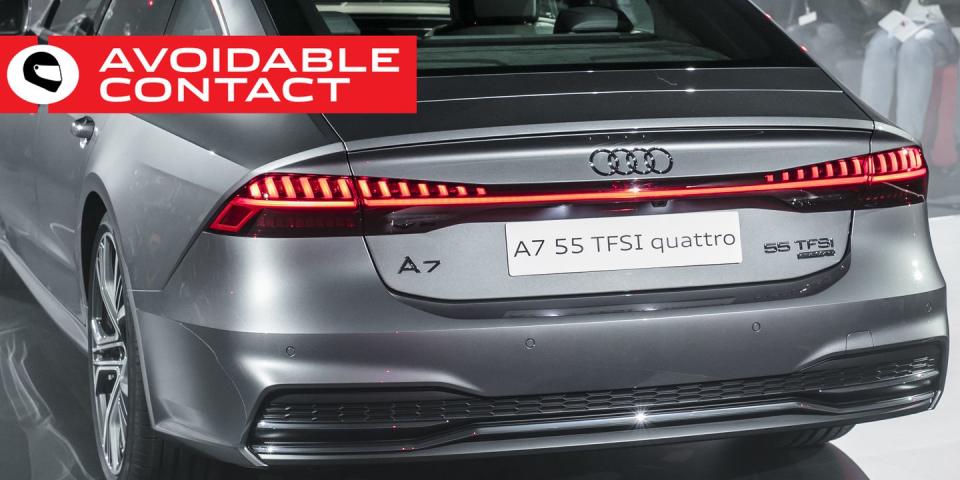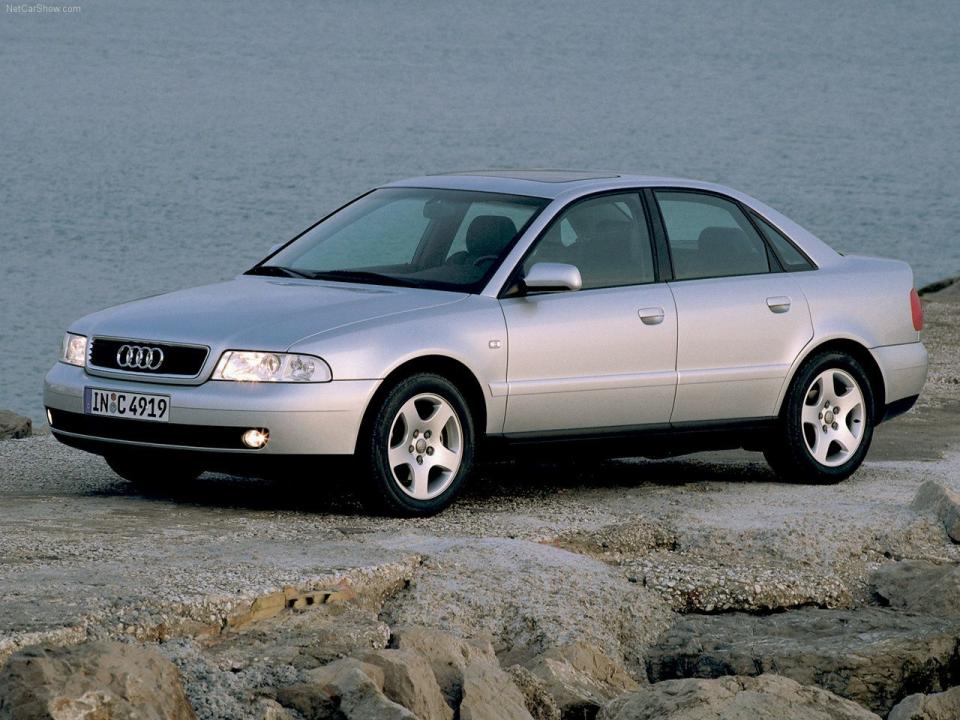Here's How We Can Make Car Model Names Make Sense

I don't know if the following story is really true, but it has what television's Judge Judy calls the "ring of truth": After the 60 Minutes fiasco of 1986, part of Audi's strategy to rehabilitate its reputation in the United States involved renaming its mainline sedans, previously called 4000 and 5000 in this market, to their European designations of 80, 90, 100, and 200. Why weren't they called that in the first place? Your guess is as good as mine; Audi sold the original 100 in America as the 100LS before changing to "5000" for the second generation.
Shown above, the 2018 Audi A7 55 TFSI Quattro, showcasing Audi's new and confusing European-market naming convention.
There's no evidence that Americans particularly liked the return to Euro-market labeling, but it did get rid of the poisonous "Audi 5000" badge. This was all well and good until the company decided to build a V8-powered Autobahn slayer to sit at the top of its lineup. This should have been called the Audi 300, but there was a problem. Mercedes-Benz already had a 300E, while BMW was selling a 325i. Neither of these cars cost as much as the proposed Audi 300. So the decision was made to call it the Audi V8 instead. That's the story, and I'm sticking to it.
Looking back at those dark days of 1990 or thereabouts, I have to ask myself: Why didn't they just call it the Audi 500? That would have lined it up against the Mercedes-Benz 500SEL, which would have been about right. Perhaps the decision had already been made to go with the A4/A6/A8 scheme, making "V8" just a stopgap. That, by the way, was what really got Audi out of the 60 Minutes doghouse-that, and the undoubted Everyman excellence of the original A4. There was also something just a bit cheeky about copying BMW's general naming strategy while turning the whole thing up one. Three series? How pedestrian. Ours goes to four.

We're now at roughly the 25th anniversary of this Audi model-naming scheme, which makes it one of the senior entries in the market. Since the first A4 arrived in showrooms, Mercedes-Benz has gone through two major conniptions in decklid lettering; Acura went from names to letters; Infiniti made everything a "Q"; Mazda divided their model numbers by just over a hundred (the old 323 is now the 3); Land Rover went to alphanumerics, then back to names. Pity the poor automotive product planner who fell asleep in 1990 only to wake up in the present day. We haven't even discussed the fact that there's another upscale brand using 80 and 90 now that Audi doesn't need those numbers any more. Now they're preceded by "G," for Genesis, a brand that has only existed on the US market since late 2016.
As a former car salesman, I can tell you the troops in the dealership trenches hate these changes with the fire of a thousand suns. They take the easiest of laydown deals-the nice folks who return their three-year lease for "another just like this one"-and make them into a forced march through the brochures that always ends with just a little bit of customer dissatisfaction. "I wanted a GLK just like my old one," the buyer will tell her neighbor, "but they made me take a GLC instead. And it's not as roomy." Cue a seven-out-of-10 on the customer satisfaction survey, followed abruptly by the disappearance of this month's bonus money.
We've now arrived at an automotive state of affairs where pretty much all of the alphanumeric names and numbers are both completely arbitrary and mostly meaningless. Take, for example, the number 300. It appears as part of several different nameplates. It never means 3.0 liters, 300 horsepower, 300 mph, or much of anything else.
What about the number 50? Sometimes it means an entry-level luxury sedan powered by a turbo four-banger, and sometimes it means a monstrous honkin' twin-turbo V-8 ... one that neither displaces 5.0 liters nor makes 500 horsepower. Sometimes 500 means what 50 means, but not exactly. Until recently, in Ford Mustang speak, it meant a 662-horse supercharged 5.4, which was nice but absolutely irrelevant to the "500" number-which in that application used to mean, wait for it, 428 cubic inches.
I could go on, but you get the idea. Forty-ish years ago, the august eminences of automotive journalism were effusive in their praise of the European automakers' oh-so-logical, oh-so-meaningful model designations-450SEL, 630CSi. Why, you could learn so much from the decklid, and it all made perfect sense, unlike the ridiculous and meaningless names like Thunderbird and Barracuda that the benighted American automakers slapped on the rumps of their junk.
The truth is that the "logical" naming schemes were never really logical-280SEL 3.5, anyone? BMW 320i with a 1.8-liter?-but they at least had the "ring of logic" to them. That's all gone out the window now.
You might laugh at my indignation, but the automakers do consumers a genuine and deliberate disservice by futzing with their badges. Quick now, without looking at any reference material: Is the X3 a competitor to the Q3? If you've just test-driven an E43, should you try a 530, a 540, a 550, or an M5 on for size? What, exactly, was the difference between the LR3 and the LR4 anyway? If you knew the answers to all those questions immediately, pretend you're shopping for a new refrigerator and you have to answer similar questions. That's about how much the average American knows about automaker branding strategies.
The obvious answer to this problem is to standardize vehicle designations. Here's how I would do it. I would come up with 26 size designations for passenger cars, from A (Smart car) to Z (Phantom limo, or maybe Navigator L.) Then I'd come up with easy-to-remember designators for various features like AWD, series hybrid, EV power, two-door, four-door, hatchback, and so on. Finally, I'd have the SAE-rated horsepower of the thing indicated right on the badge. Using a rough version of my idea, we see that the BMW 430i hardtop xDrive becomes the BMW GAC-248. The C300 hardtop coupe with AWD is the Mercedes-Benz GAC-255. The Audi A5 2.0T coupe? It's the Audi GAC-252. My Accord coupe, about which you readers never tire of hearing? It's the Honda HFC-272. And a Mustang Ecoboost, assuming Ford wants to play? It's a Ford HRC-310.
These are not compelling names, but they are informative. They place the BMW, Benz, and Audi on rightful common ground, while acknowledging that the Honda and Ford are a little bigger and more powerful. You could quickly and easily narrow down a list of potential purchases with these names. "Hmm... I want a crossover in the F size range with about 200 horsepower."
The automakers might gripe a little bit about this, but they would be secretly thrilled. Why? It's simple. All of them want their brand name to be more powerful than their model names. Otherwise you get the situation where people can't find the "Legend dealership" anywhere, and they end up buying a Lexus instead. Mercedes-Benz has no emotional attachment to its model codes-if it did, we wouldn't have this business of GLC/GLE/GLS, all of which trace their immediate nomenclature heritage back to ... an extended-wheelbase ML320 built in Alabama that debuted a decade ago.
I can't see any drawbacks to this modest proposal, but I'd like to add an exception right up front: Every automaker has the option to give up its state-assigned alphanumerics in favor of a real, honest-to-God name like Tempest, Fury, Cordoba, Jupiter, or something like that. If you do that, you can't have any extra badging. Don't try to cheat my rule by doing a "Munich M550i xDrive GT," or I will strike down upon thee with great vengeance and furious anger, et cetera. Just call it the "Munich" and we're cool.
Now everybody wins. The people who buy cars like refrigerators can have their refrigerator names. And the enthusiasts can have Cyclones and Bearcats and whatnot. The kind of people who buy the "name" cars won't need the badge to tell them what they've got. The same way that I know that an E43 is a very sensible power sedan while a C63S is Mr. Toad's Wild Ride. You knew that too, of course, but does your neighbor? Judge Judy, I rest my case!
('You Might Also Like',)

 Yahoo Autos
Yahoo Autos 